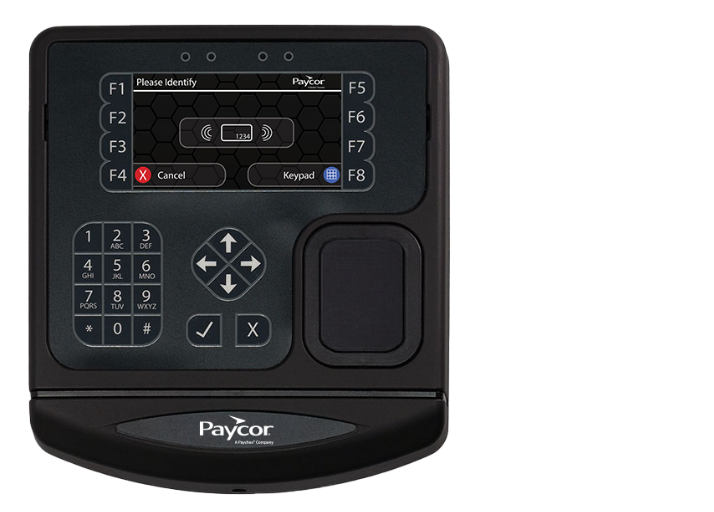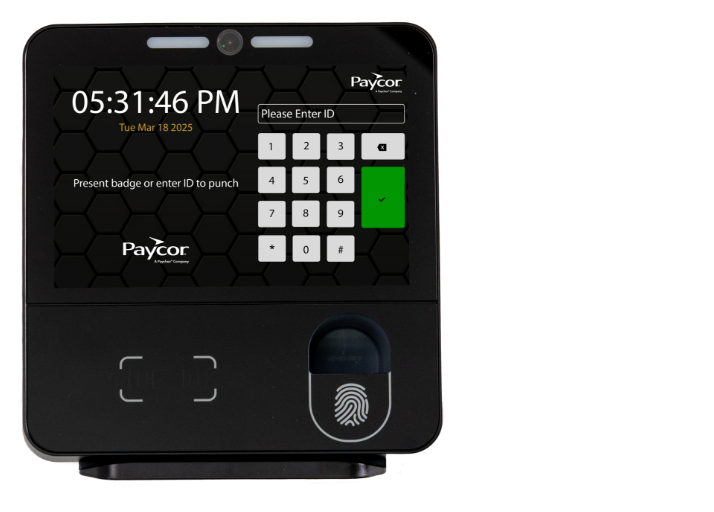In the business world, time is your most valuable and finite resource. How you manage employee time directly affects your organization’s productivity, profitability, and ability to meet regulatory requirements. What was once considered a nice-to-have has now become a must-have for any successful organization.
This guide will walk you through everything you need to know about employee timekeeping, from the basics to modern, efficient solutions. We’ll break down the advantages of implementing a dedicated timekeeping system and show how Paycor’s innovative tools can help you optimize workforce management.
What is Timekeeping and Why Does it Matter?
Timekeeping goes far beyond simply punching a clock. It’s about carefully tracking multiple aspects of employee time:
- Recording exact clock-in and clock-out times
- Monitoring breaks and lunch periods to comply with company policies and labor laws
- Managing Paid Time Off (PTO), including vacation and sick leave
- Tracking overtime hours to ensure proper compensation and control labor costs
- Documenting time spent on specific projects or client work for businesses operating on a project basis
Why does accurate timekeeping matter so much? Let’s break it down:
Productivity Boost
When employees know their time is being tracked precisely, they naturally become more punctual. It also reduces instances of time theft such as buddy punching or taking longer breaks than are permitted. Automated systems free up HR and payroll staff to focus on strategic work instead of manual tracking.
Compliance Protection
Labor laws such as the Fair Labor Standards Act (FLSA) require meticulous record-keeping of employee hours. Proper timekeeping helps you avoid potential penalties, audits, and legal headaches.
Cost Control
Detailed time tracking gives you a clear picture of labor expenses. You can identify areas to optimize, manage overtime proactively, and create more accurate budgets.
Strategic Insights
Modern timekeeping systems generate reports that reveal workforce trends, help with staffing decisions, and highlight patterns in attendance.
Employee Trust
Transparent and accurate time tracking builds employee confidence. When workers see their hours and pay calculated fairly, it reduces disputes and boosts morale.
What Can a Timekeeping System Do?
Gone are the days of paper timesheets and manual calculations (at least it should be). Today’s timekeeping systems offer:
- Automated time tracking through digital clocks, mobile apps, and web interfaces
- Increased accuracy through reduced human error
- Seamless payroll system integration
- Real-time visibility into attendance and labor costs
- Simplified time-off request management
- Customizable reporting and analytics
- Automatic compliance monitoring
- Support for mobile and remote workforce management
Benefits of Implementing a Timekeeping System
Implementing a timekeeping system solves several critical business challenges. Most importantly, it cuts down on payroll errors. Manual calculations are a minefield of potential payroll mistakes—missed hours, incorrect overtime, wrong pay rates. An automated system eliminates these risks, saving your business money and headaches.
Instead of getting buried in paperwork and manual calculations, your HR team can focus on actual people management. No more spending hours tracking down timesheet discrepancies or manually entering data. The system does the grunt work, freeing up your team to handle more important tasks.
Labor laws change constantly, and one mistake can lead to expensive penalties. A good timekeeping system stays updated with current regulations, acting like a built-in compliance guard. It tracks everything from overtime to break times, keeping you out of legal trouble.
Self-service time tracking lets employees see their hours and verify their pay. This builds trust and dramatically reduces payroll disputes. When workers can see exactly how their time is calculated, they feel more secure and valued.
But the real power is in the data. These systems generate reports that show you exactly how your workforce operates. You’ll see clear patterns in staffing, labor costs, and productivity. This isn’t just numbers—it’s actionable intelligence that helps you make smarter decisions about scheduling and resource allocation.
As your business grows, the system grows with you. Whether you’re adding employees or expanding to new locations, a good timekeeping system adapts seamlessly. It’s not just a tool—it’s a scalable solution that supports your business at every stage.
The bottom line? These systems save money. By tracking labor costs precisely, identifying overtime patterns, and streamlining payroll, you’ll see real financial benefits. What looks like a tech expense quickly becomes a strategic investment.
Types of Timekeeping Systems
Depending on your business, you can find various timekeeping solutions to fit different needs:
- Electronic Time Clocks: Physical devices ranging from badge systems to biometric scanners
- Web-Based Software: Cloud platforms for computer-based time tracking
- Mobile Apps: Smartphone solutions for remote and field workers
Why Choose Paycor for Employee Timekeeping?
In today’s rapidly evolving business environment, your organization requires a timekeeping solution that is not only powerful and accurate but also flexible and user-friendly. Our comprehensive suite of timekeeping options is designed to meet the diverse and evolving needs of modern businesses.
Paycor’s timekeeping solutions are built with several key advantages in mind. Paycor Time seamlessly integrates with Paycor’s full Human Capital Management (HCM) platform, which includes payroll, HR management, and talent management. We place a high priority on ease of use for both employees and administrators. Intuitive interfaces and ready mobile accessibility make time tracking a simple and efficient process for everyone.
Whether your organization is a small business or a large enterprise, our timekeeping solutions are designed to grow as your business does, ensuring long-term value. Our support teams and comprehensive resources provide smooth implementation and ongoing success with your timekeeping system. Even better, our systems are designed to help you remain compliant with complex and frequently changing labor laws and regulations.
Explore Paycor’s Timekeeping Solutions: Find the Right Fit for Your Business
We offer a range of timekeeping options, ensuring you can find the perfect solution to match your organization’s needs, workforce structure, and budget.
PT300: The Reliable and Efficient Time Clock

- Ideal for: Small to medium-sized businesses looking for a dependable, no-frills electronic time clock solution.
- Key Features:
- Proximity Badge Reader: Employees simply swipe their badge for quick and easy clock-ins and clock-outs.
- User-Friendly Interface: Simple navigation and clear display for straightforward employee use.
- Real-Time Data Capture: Captures time data instantly, providing accurate records for payroll.
- Integration with Paycor Time: Seamlessly integrates with Paycor Time software for centralized data management and reporting.
- Cost-Effective Solution: A budget-friendly option for businesses transitioning from manual timekeeping.
PT400: Advanced Time Clock with Enhanced Features

- Ideal for: Businesses seeking a more sophisticated time clock with added functionality and employee self-service capabilities.
- Key Features (Building upon PT300):
- Color Touchscreen Display: Intuitive and interactive touchscreen interface for enhanced user experience.
- Employee Self-Service: Allows employees to view timecards, request time off, and view schedules directly at the clock.
- Multiple Clock-In Options: Supports badge swipe, PIN entry, and optional biometric (finger template) verification.
- Advanced Data Collection: Captures labor data for job costing and department tracking.
- Enhanced Reporting: Provides more detailed data and reporting capabilities within Paycor Time.
PT800: The Biometric Powerhouse for Maximum Accuracy

- Ideal for: Organizations prioritizing the highest level of accuracy and security, particularly those concerned with buddy punching and time theft.
- Key Features (Building upon PT400):
- Biometric Finger Template Reader: Utilizes advanced finger template recognition for foolproof employee identification.
- Eliminates Buddy Punching: Ensures accurate time records by preventing employees from clocking in for each other.
- Robust Security: Provides a highly secure method of time tracking, minimizing time fraud and boosting payroll accuracy.
- Durable and Reliable: Built for demanding environments and high-volume usage.
- Comprehensive Data Management: Integrates seamlessly with Paycor Time for complete workforce management.
Paycor Time Mobile Clock: Timekeeping in the Palm of Your Hand

- Ideal for: Businesses with remote employees, field service teams, or organizations embracing flexible work arrangements.
- Key Features:
- Offline Mode: Allows employees to track time even without internet connectivity; data syncs when a connection is restored.
- Push Notifications & Reminders: Keeps employees informed with shift reminders, approval notifications, and other important updates.
- Seamless Integration: Fully integrated with Paycor Time, providing a unified timekeeping experience across all devices.
- Cost Savings: Reduces the need for physical time clocks in remote locations, lowering hardware costs.
Embrace Efficient Timekeeping for a Thriving Business
Effective employee timekeeping is the cornerstone of efficient workforce management. By moving beyond outdated manual methods and embracing technology-driven solutions like Paycor Time and our suite of devices, you can unlock significant benefits for your organization. From boosting productivity and helping ensure compliance to controlling labor costs and enhancing employee satisfaction, investing in the right timekeeping system is an investment in your business’s long-term success.
Ready to explore how Paycor’s timekeeping solutions can transform your workforce management? Contact us today.
FAQs About Employee Timekeeping
What is a time keeping system?
A timekeeping system is a method or tool used to track the hours worked by employees. It can range from manual paper timesheets to sophisticated electronic or software-based solutions. The primary goal is to accurately record work hours for payroll, compliance, and workforce management purposes.
Why does timekeeping matter in HR?
Timekeeping is fundamental to HR for several reasons:
- Accurate Payroll: Ensures employees are paid correctly for the time they work, preventing wage disputes and maintaining employee satisfaction.
- Compliance: Helps organizations adhere to labor laws and regulations related to hours worked, overtime, and record-keeping.
- Workforce Management: Provides data and insights for effective scheduling, labor cost control, and productivity analysis.
- Legal Protection: Accurate time records serve as legal documentation in case of audits, disputes, or legal claims related to wages and hours.
How do you keep track of time that is worked by employees?
Businesses use various methods to track employee time, including:
- Manual Timesheets: Employees manually record their start and end times on paper.
- Electronic Time Clocks: Physical devices where employees clock in/out using badges, PINs, or biometrics.
- Timekeeping Software: Web-based or cloud-based systems that allow employees to clock in/out via computers or mobile devices.
- Mobile Time Tracking Apps: Applications for smartphones and tablets that enable remote time tracking.
How do I track my employees’ hours?
To effectively track employee hours, you should:
- Choose the Right System: Select a timekeeping method or system that aligns with your business needs and budget. Consider factors like accuracy, ease of use, integration capabilities, and scalability.
- Establish Clear Policies: Develop and communicate clear timekeeping policies to employees regarding clock-in/out procedures, break times, time off requests, and error correction processes.
- Provide Training: Train employees and managers on how to use the chosen timekeeping system and understand timekeeping policies.
- Regularly Monitor and Audit: Periodically review time records for accuracy, identify and correct errors promptly, and monitor for potential time theft or compliance issues.
- Use Reporting and Analytics: Leverage the reporting features of your timekeeping system to gain insights into labor costs, attendance patterns, and productivity trends.









